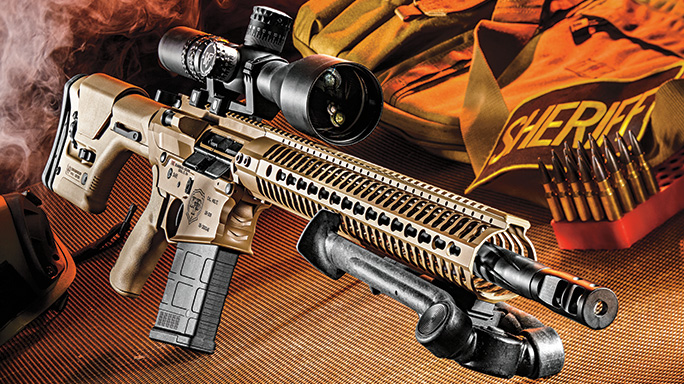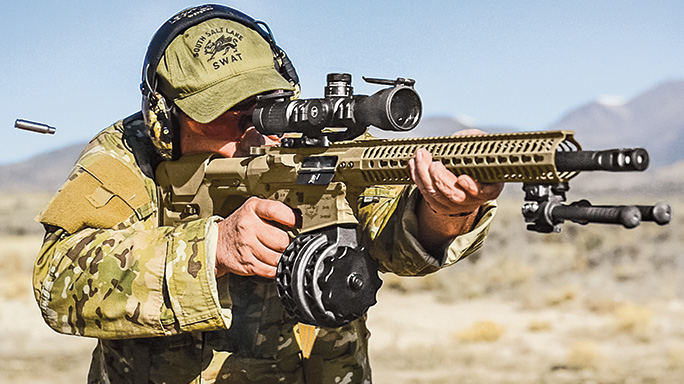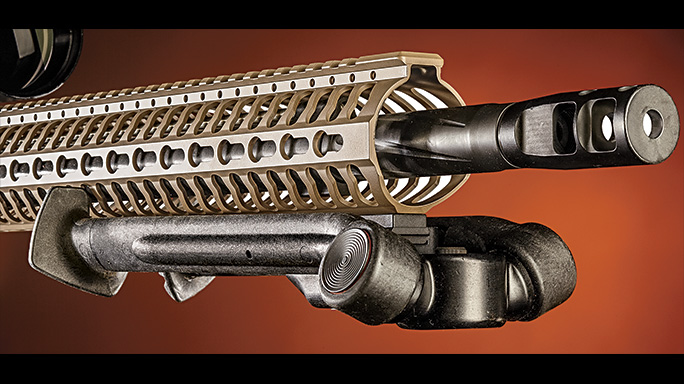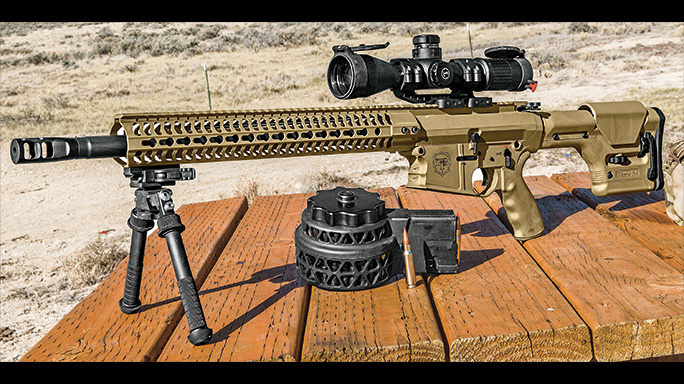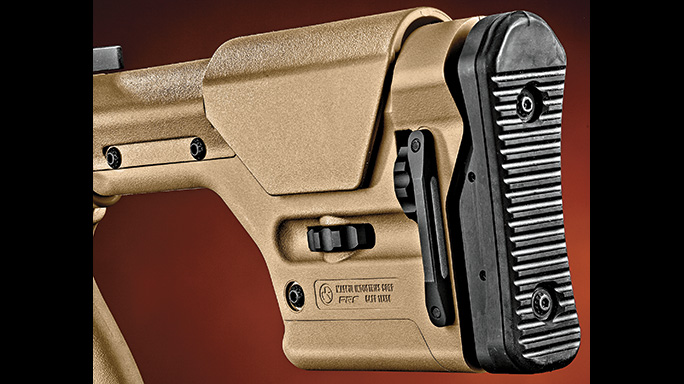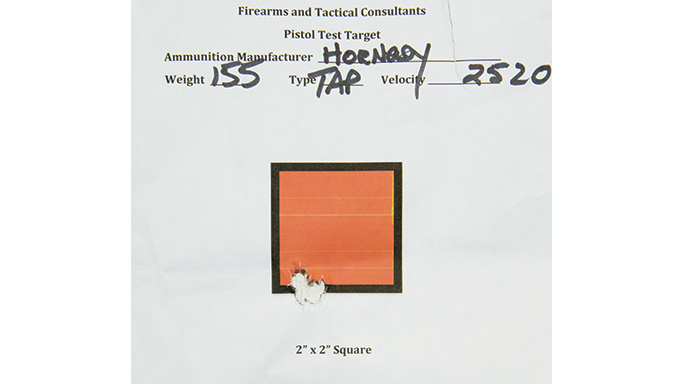This is turning out to be the year of the 7.62mm NATO AR-platform rifle. As the dust settles on the numerous 5.56mm NATO versions, their big-bore brethren are becoming increasingly popular in general, as well as in law enforcement. Some officers and departments have a need for a truly duty-capable 7.62mm AR. Rural agencies, for example, need the longer range. Urban departments will issue DMR versions of these rifles to their dedicated marksmen, or even select patrol officers. There are just some things the 5.56mm does not do as well as the venerable 7.62mm. Coupled with a marksman’s bolt-action rifle in the same chambering, a 7.62mm AR provides increased versatility and training compatibility.
- RELATED VIDEO: Diamondback’s New Big-Bore DB10E in 7.62mm NATO
For years, however, there were few choices when it came to 7.62mm ARs. Many were unreliable, marginally accurate and grossly overpriced. That has slowly changed, with huge improvements over the past few years. In general, the reliability of these ARs has increased over a broader range of ammunition. Weight is being shaved with every passing evolution, and their accuracy has improved significantly. Several of the rifles I’ve tested in the past few months have matched or exceeded all but the most expensive bolt actions. Changes in bullet construction have also eliminated the need in many instances for special barrier rounds, removing another obstacle that affected reliability. If I were to deploy today, my rifle would be a semi-auto AR in 7.62mm NATO.
Diamondback recently entered the 7.62mm market with its DB10 series of rifles. Unveiled in January of 2015, they were very popular, and given the popularity of the company’s 5.56mm DB15 series, that’s quite understandable. These rifles are a favorite for many because they’re built to very high standards and have proven themselves as reliable and accurate. I recently got my hands on Diamondback’s 7.62mm DB10EFDE to wring it out on the range.
Advertisement — Continue Reading Below
Gun Details
For the DB10EFDE, Diamondback starts with upper and lower receivers CNC-machined from a billet of 7075-T6 aluminum, which maintains strength without adding a lot of weight. The upper houses an 18-inch, heavy, chrome-moly barrel that sports some stylish fluting, has a 1-in-10-inch twist rate and utilizes a mid-length gas system. The barrel is capped with a JP Enterprises JPTRE-424 compensator to help reduce recoil. Standard on many professional competition rifles, this muzzle brake meets the requirements for many tactical matches.
Surrounding the barrel and gas system is a 15-inch, lightweight KeyMod handguard that has a long top rail for mounting optics, and users can add accessories where needed along the sides and bottom. Also, the bolt carrier group is made from 8310 steel that is given a black nitride finish for enhanced durability and corrosion resistance.
Advertisement — Continue Reading Below
The lower receiver features an integral triggerguard that is large enough for gloved use as well as a flared magazine well for faster reloads. An Ergo pistol grip keeps things comfortable. Diamondback also includes a rifle-length buffer and spring as well as Magpul’s proven PRS stock. CMC triggers have been showing up on a lot of my test rifles lately, and this rifle was no exception. This trigger unit is a one-piece design that was installed using anti-walk trigger and hammer pins. Factory set at a crisp 3.5 pounds, CMC’s triggers have proven to be reliable and rugged.
Finally, the receivers and furniture are finished in Flat Dark Earth. In all, the DB10EFDE has a really nice look, with some contrasting red and black colors in the receiver markings. Weighing in at 10.5 pounds unloaded, the DB10EFDE is typical of most AR-platform rifles.
Given this AR’s tasking as a precision or duty AR, I installed my Leupold 3-18x44mm Mark 6 scope in an Alamo Four Star mount. Using a Horus H58 reticle, the Mark 6 is perfectly suited to duty use. Mounted in the first focal plane, the reticle’s holds and ranging are accurate at any power setting. Horus’ proven design allows for wind and elevation holds at very long distances, and it offers a relatively clear sight picture. It also allows for fast ranging using the 12-inch target brackets within the scope. Leupold’s pinch-and-turn knobs are also excellent for duty work. Graduated in mils, they offer all the elevation you would ever need and require you to pinch then turn, eliminating any accidental adjustments. Leupold’s zero-stop feature is one of the easiest on the market to use. Once set, you have an absolute return to your zero—just run the knob to the bottom.
Advertisement — Continue Reading Below
I’ve used this scope on several test rifles, at a number of training schools and even on a few hunts. It is incredibly versatile. I use Aadland Engineering’s Aadmount scope caps to cover the glass. These have withstood a year of hard use without a scratch. They are excellent covers, especially where your scope encounters any hard use. The only other addition to the rifle was an Atlas bipod, which fit perfectly on a bottom rail attached to the KeyMod handguard.
Range Time
At the range, I started by testing the rifle’s reliability while shooting from some less than conventional positions. I used steel and paper targets set out from 50 to 400 yards, firing from kneeling, off-hand and various supported positions. I also used the bipod for support at times, along with my WieBad Tac-Pad. This handy little device lets you lock solidly into positions that approximate being seated or kneeling without taking as much time or balance. The DB10EFDE did very well, allowing me to get reasonably consistent hits on steel targets as small as 6 inches at 400 yards. All of this was completed using the Horus reticle for wind and elevation corrections. The only time I dialed in the elevation was for groups at 300 yards. The rifle proved accurate and reliable, with an affinity for Hornady’s 155-grain TAP round.
Advertisement — Continue Reading Below
Next was some deployment-style training. I set the DB10EFDE up like a deployment rifle, placing it in a bag in my truck. Then I would simulate callouts, removing it from the truck and shooting from a number of positions, all under time constraints. I generally had to run to the final shooting position. To simulate a rural environment, I took shots out to 200 yards, hitting silhouettes with concentrated target areas in the 3-inch range attached. Firing from barricades, or even my truck, yielded hits inside the 3-inch circle with consistency. Field conditions seldom yield the opportunity for prone shooting, so I didn’t use the bipod for this portion of the testing. The DB10EFDE acquitted itself well here.
Moving to more typical police marksman deployments, I pulled the rifle from my drag bag and got into a final firing position. After setting up, I fired a cold-bore shot into a 1-inch target at 100 yards. Five total cold-bore shots were completed, and they all stayed inside the 1-inch circle. Follow-up groups were very consistent. All cold bores were completed on a fouled barrel. The overall accuracy was consistently 1 MOA or less, making this rifle suitable for most applications.
Static accuracy testing was equally impressive. Half-inch groups seem possible with this rifle. During testing, the Hornady TAP ammo won the day with a group measuring right at 0.6 inches. Everything fell under 1 inch, with several groups hovering around the 0.75-inch mark. Moving out to 300 yards, groups were mostly in the 2.5- to 3.5-inch range. Wind was a factor, so these results are pretty solid. The DB10EFDE seemed to hold at least 1 MOA on paper out to 300 yards, while maintaining that out to 400 yards with steel targets.
Advertisement — Continue Reading Below
After about 100 rounds, the rifle was pretty dry, and the action started failing to lock open after the last round with PMAGs. Adding oil seemed to fix it right up, but this rifle liked to run on the wet side. I used several magazines from Lancer, DPMS, LaRue Tactical and Magpul’s Gen 1 and Gen 2 PMAGs. Everything worked well when the rifle was oiled properly, with a slight edge towards the Lancer L7AWM magazines. It was also much easier to shoot from unsupported prone with these mags in place. It helps that they sit flat, especially when shooting at ranges under 200 yards. Lying in a prone position with no support, it was much easier to get solid hits on the 6-inch steel at 300 yards.
Rifles designed for use with optics are better served with an extended charging handle. All 7.62mm ARs should have one, as the spring pressure and mass of the bolt are greater. Running a standard handle from prone with a scope and/or offset sights can be problematic. There are several companies making these kinds of charging handles now, and I’d add one to this rifle.
- RELATED STORY: Diamondback’s DB15NIB Is Ready For Duty, Defense or Sport
I don’t like muzzle brakes for duty rifles. As far as brakes go, this JP Enterprises model is one of the best, but it is still loud; a shot without hearing protection on a deployment would be very painful. The brake does control recoil and muzzle rise, but given real-world applications, a solid grip would also fix those issues. If you are headed to a 3-Gun match, this is a great brake, but I would replace it with a flash or sound suppressor for LE engagements.
Advertisement — Continue Reading Below
Final Notes
Diamondback has put together a very nice entry into the 7.62mm AR market with the DB10EFDE. Overall, its fit and finish are excellent and its billet receivers are nicely mated. The rifle’s accuracy was excellent, its reliability was solid, and it felt comfortable. It performed well given some typical LE training. Overall, it’s an excellent rifle. If you’re in the market for a 7.62mm AR, give this one a close look.
For more information, visit diamondbackfirearms.com or call 877-997-6774.
Advertisement — Continue Reading Below
